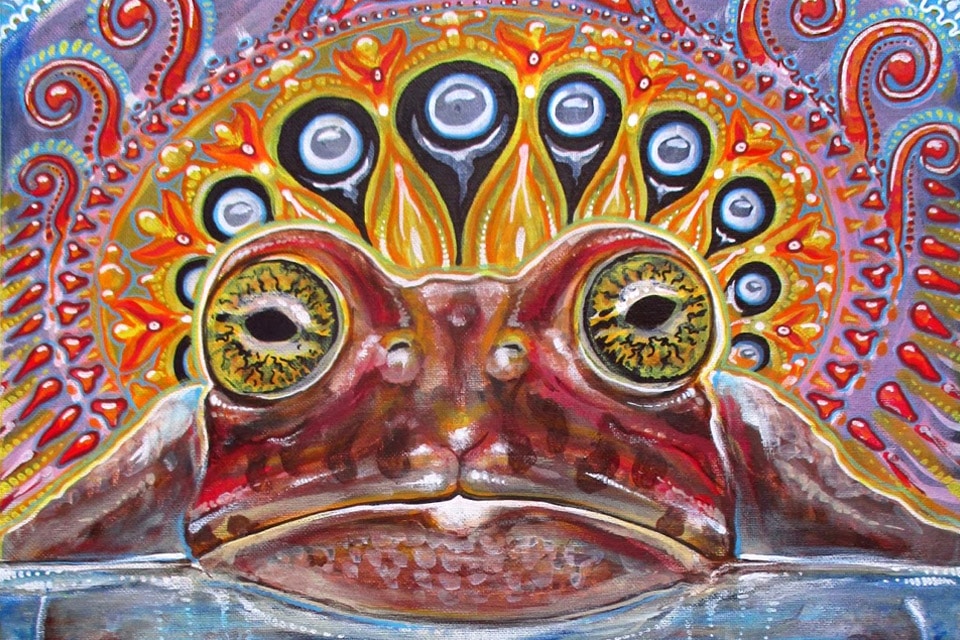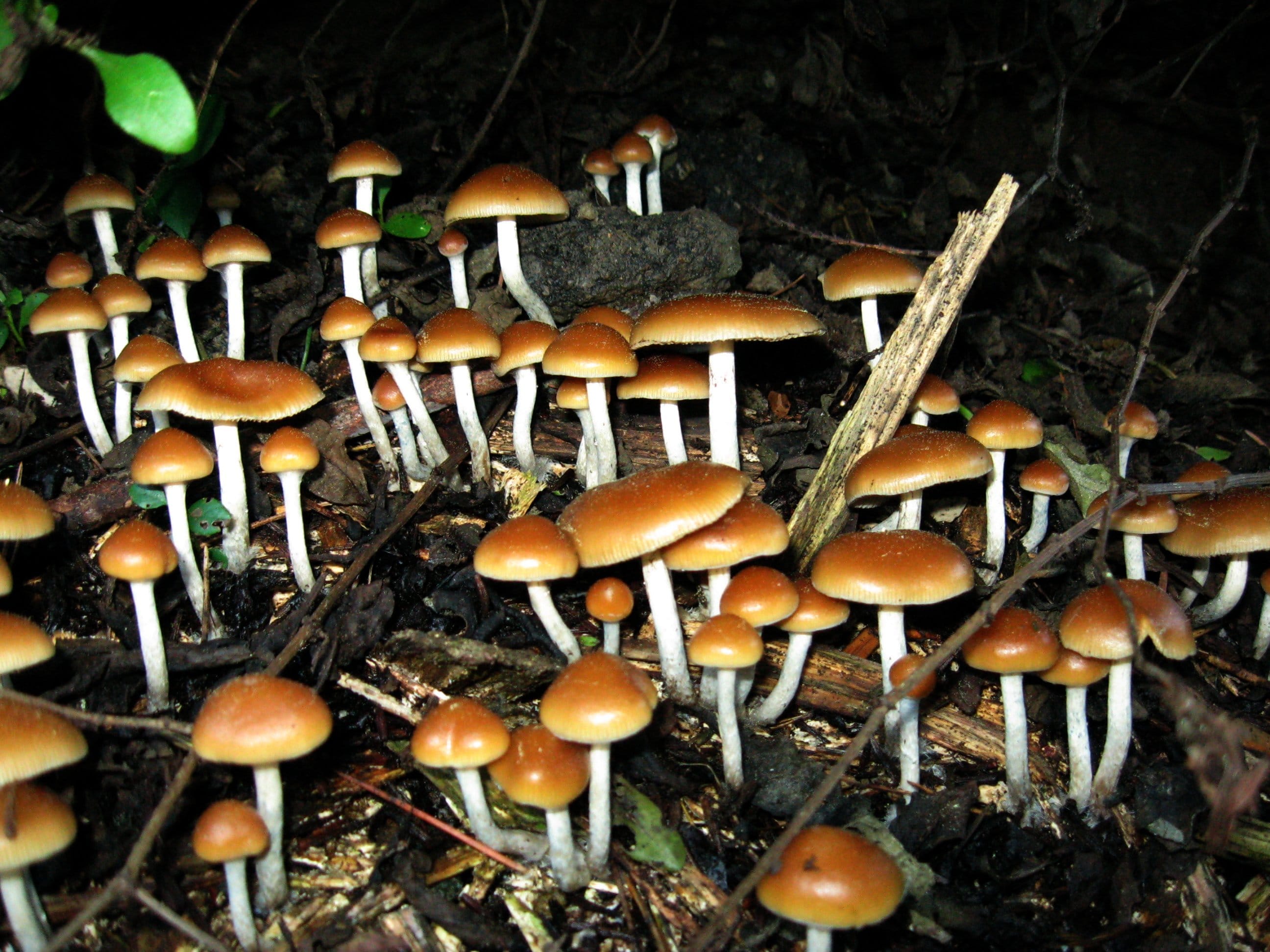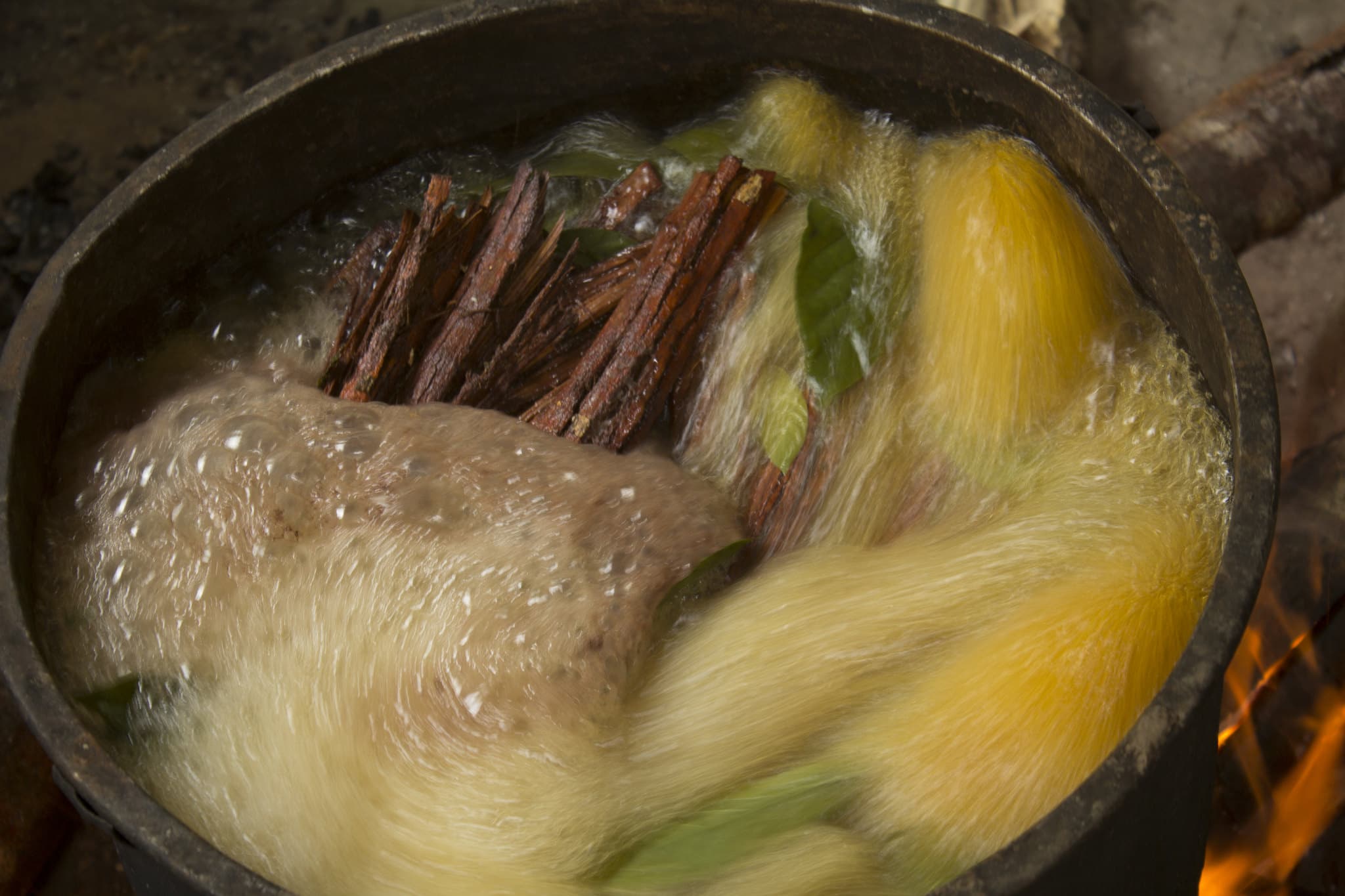
This article on the psychedelic toad is a guest post by Sean Lawlor (@seanplawlor). Sean is a writer and student of Transpersonal Counseling at Naropa University, with intention to practice ethical, above-ground psychedelic therapy. His journalism focuses on psychedelic medicine, drug policy, and issues around diversity, and his work has been featured in Chacruna, The Rumpus, and Rooster Magazine.
Featured image: Żabka by Michael Garfield.
If you hang around psychedelic communities these days, you’ll probably hear someone talking about “the toad.” Even if you don’t hang in such circles, you might still hear about it, cause folks ranging from Tony Robbins to Mike Tyson are claiming the toad obliterates the ego, drastically altering perception on life as a whole.
This psychedelic toad is Bufo alvarius—better known as the Sonoran Desert Toad—and its venom contains the highest naturally-occurring concentration of the psychedelic 5-MeO-DMT in the known universe. When this venom is sun dried and vaporized, it incites what many deem the most powerful psychedelic experience one can experience, powerful enough to KO Tyson’s ego within seconds, then facilitate his re-emerging as if reborn.
But don’t mistake it for “regular” DMT, the substance known to blast people beyond their bodies within seconds of ingestion into fractal-morphing landscapes of alien entities and Joe Rogan. That’s N,N-dimethyltryptamine, and we’re talking about 5-methoxy-N,N-dimethyltryptamine. It appears almost identical both in structure and name, and also acts within seconds, but that extra methoxy group is sufficient enough to facilitate an experience of an entirely different nature.
An Expert on the Matter
According to Rafael Lancelotta, psychedelic-assisted-therapist of Innate Path in Denver and prominent 5-MeO-DMT researcher with whom I recently spoke, a key difference is that while many ascribe an “observer quality” to regular DMT, 5-MeO-DMT “can dissolve any ego or sense of self,” inciting an experience of “becoming everything.” One’s lens on life zooms out, opening the mind to a nondual experience of “pure consciousness,” a sense of “inherent belonging to all the energy of the universe.”
Our conversation got mystical fast. And it turns out that’s significant, for as the results of a 2017 Beckley Foundation/Imperial College London study demonstrated, mystical-type experiences—including those incited by psychedelics—are connected with noteworthy improvements in treatment-resistant depression. By extension: 5-MeO-DMT’s powerful mystical quality could have direct correlation with powerful therapeutic potential.
5-MeO-DMT and Mystical Experiences
During his graduate studies in counseling, Lancelotta joined a 5-MeO-DMT research team arranged by Drs. Alan Davis and Joseph Barsuglia. Since the substance’s Schedule I status barred them from pursuing clinical trials, the team focused on Crossroads Ibogaine Treatment Center in Mexico, which at the time administered Bufo venom to help people overcome addiction. The team administered the Mystical Experience Questionnaire to twenty people who had experienced the psychedelic toad, then cross-referenced the results with data from Johns Hopkins’ studies on psilocybin mushrooms, for which participants had filled out the same questionnaire.
The results, published in late 2018, reported that 5-MeO-DMT “reliably occasioned complete mystical experiences in 75% of individuals… similar in intensity to high dose psilocybin administered in a laboratory setting.” Given the established link between mystical experiences and reduced depression, the 5-MeO-DMT team concluded: “Further research is warranted on the use of 5-MeO-DMT as a potential therapeutic agent in the treatment of multiple mental health issues.”
While such a study was insufficient to open the door for clinical trials, it provided a stepping stone. From that stone, Lancelotta joined a new group that Dr. Alan Davis formed to take the research further.
A Brief History of the Mystical Experience Questionnaire
The first scientific study of psychedelic-occasioned mystical experiences was the Marsh Chapel Experiment of 1962, better known as the “Good Friday Experiment.” Led by Harvard graduate student Walter Pahnke, under the supervision of Timothy Leary and Ram Dass (then called “Richard Alpert”), the study administered psilocybin to ten Theology students and placebos to ten more. Pahnke developed a lengthy questionnaire to quantify intensity of mystical experience, gave it to the participants, and discovered that nine out of ten students who received psilocybin had mystical experiences, while only one of the placebo group experienced the same. Follow-up studies added further support to the theory that psychedelic drugs can occasion mystical experiences, a theory many researchers stand by today.
After the study, Pahnke continued fine-tuning the questionnaire, ultimately reducing it to 43 items. This version remained the scientific standard until 2012, when Dr. Katherine MacLean revised it into a 30-item form focusing on four key factors: mysticism (i.e. internal unity, “noetic” quality), positive mood, transcendence of time and space, and ineffability. It’s this 30-item version that the 5-MeO team and other researchers use today, connecting these studies to the lineage of research that showed such promise before Dick Nixon shut it down.
Continuing Research: A Survey Study
Seeking broader data, the Davis-led research team created an in-depth survey to investigate patterns experienced among underground 5-MeO-DMT users. The Mystical Experience Questionnaire was included, but it was now paired with several more categories, including questions concerning mental health. The study’s results, published in March of 2019, attracted a good deal of attention.
From the 515 respondents representing the “global population,” the researchers isolated a subset who used 5-MeO-DMT in a structured, ceremonial setting—a significant distinction because, as Lancelotta explained in his presentation at Breaking Convention: “That setting was similar to what you might see in a clinical trial.” Of the subset, 80% of respondents reported improvements in depression symptoms, and 79% reported improvements in anxiety. In line with the Beckley/Imperial study, these improvements were correlated with increased intensity of mystical experiences—a trend that also proved consistent for the 79% of global population respondents who reported improvements in PTSD.
Lancelotta explained to me that on top of inducing mystical experiences, 5-MeO-DMT can “enhance the emotional memory stored in the body.” Since humans store trauma somatically—that is, in the body—Lancelotta argues such enhanced awareness “could help someone who is completely disconnected from their body have a heightened awareness and begin to process things that are stuck.”
Fascinating as it may be, this talk on enhanced awareness and staggering data sounds familiar; after all, researchers at MAPS and Johns Hopkins are presenting comparable results with MDMA and psilocybin. So why use some strange psychedelic toad venom when psilocybin and MDMA are already well underway with clinical trials?
Let’s let Dr. Alan Davis answer that one.
“Psychedelic sessions usually require 7-8 hours per session because psychedelics typically have a long duration of action,” Davis reported to Johns Hopkins Medicine. “Because 5-MeO-DMT lasts approximately 30-90 minutes, it could be much easier to use as an adjunct to therapy.”
But time isn’t really the concern. The bigger concern is money.
Generally, therapists charge between $100-200 an hour. Current models of MDMA and psilocybin-assisted psychotherapy involve two therapists at a time. On top of the 7-8 hour sessions—MAPS has three in their 5-month protocol—clients must undergo several preparatory and integration sessions to achieve optimal results. In the end, MAPS estimates MDMA-assisted psychotherapy will cost a minimum of $13,000, though perhaps up to $30,000.
MAPS is actively seeking solutions to the problem; as Rick Doblin observes, “A lot of time those people that are most traumatized have the least resources.” But the road to access remains unclear, and even if psychedelic therapy does become legal in the next few years as forecasted, it’ll be several more years before insurance companies even consider covering it.
5-MeO-DMT is in a unique position of opening psychedelic therapy to a broader population, while also opening opportunities for medicated sessions to happen more frequently. That’s important because, as Lancelotta reminded me in our conversation, no psychedelic is a panacea capable of magically and instantaneously curing complex mental illness. Long-term healing requires a multi-session therapeutic relationship, regardless of which drug or modality catalyzes the healing.
Psychedelic Toad Venom in the Therapy Room?
Aligned with his approach to cannabis and ketamine, Lancelotta envisions administering 5-MeO-DMT in a calm, controlled setting such as a therapy office, with participants wearing eyeshades, and optionally having music playing through speakers. The therapist provides support and guidance, helping clients process what emerges, especially if it’s frightening. And given its potency, vaporized toad venom can scare the bejesus out of people, as happened to Michael Pollan.
“It was horrible,” Pollan told Joe Rogan on a podcast. “It was terrifying. I thought I was dying.”
Stroll through 5 Hive, the 5-MeO-DMT forum Lancelotta created, and you’ll find death sensations common amongst high-dose experiences. But high-dose experiences are not the only option—and in Lancelotta’s mind, they’re not ideal for therapy.
Since toad venom is so potent, Lancelotta argues for synthetic production of the molecule. On top of being relatively simple to produce—compared, that is, to substances like MDMA—synthesized 5-MeO-DMT would allow therapists to support the administration of low, controlled doses to clients. While some use the “it’s-organic-and-therefore-better” argument on behalf of toad venom organic, others, such as Joe Rogan, report synthetic induces equally-powerful and significant experiences.
“What’s fascinating is that even at lower doses,” Lancelotta explained, “5-MeO-DMT can still connect someone to that sense of I am part of a much bigger story, and do so in a way that’s supportive without being terrifying. It can actually be quite gentle.”
Alas, experiencing the absolute terror of your death’s rapid onset is not a prerequisite for a mystical experience. Hoorah! And administering a controlled dose of synthetic 5-MeO-DMT via intramuscular injection could allow for a slower onset, increasing the gentleness of the experience and further alleviating potential terror.
Lancelotta summed up the approach:
“The goal wouldn’t be to put someone in a state of mind where they weren’t able to communicate. It wouldn’t be a session where the whole system is completely overwhelmed and they’re dissolving into white light. The idea isn’t to create a stress response, but to allow the system to naturally resolve stress responses.”
Of course, some still seek the “peak” experience. After all, this high-dose/low-dose debate has circulated since the early days of psychedelic research, reflected through low-dose “psycholytic” therapies of Europe and high-dose “psychedelic” therapies in the U.S. The former allows verbal and somatic-processing, while the latter obliterates the ego. The debate even manifests in current models of ketamine-assisted psychotherapy: Some therapists offer high-doses, where participants become so removed from their bodies, they lose the ability to speak, while others—Lancelotta included—support low-dose sessions, so the participant maintains body awareness and stays in contact with the therapist through the session. Some use both approaches, depending on the client, and the client’s specific condition. But when it comes to high-dose 5-MeO-DMT, the most practiced form of administration—vaporizing Bufo venom—raises unique ethical concerns.
5-MeO-DMT has become quite popular, and its popularity has directly affected the Sonoran Desert Toad. Populations have dwindled in recent years. Initiatives have arisen to protect Bufo alvarius, and even some of 5-MeO-DMT’s strongest proponents concede toad ceremonies are not a sustainable model.
One such proponent is Gerardo “Gerry” Sandoval, who has made a living conducting psychedelic toad ceremonies for years. And Sandoval takes us a layer deeper into these ethical concerns, for he, along with another well-known Bufo facilitator named Octavio Rettig, has recently been defamed as not only a charlatan, but a highly-dangerous individual.
Dark Underbelly of the Psychedelic Toad
Hamilton Morris visited Sandoval for his show, Hamilton’s Pharmacopeia. Sandoval looked like a cheery, good-natured cowboy—yet there was something off-putting about the way he spoke of the importance of protecting the toad, and yet clearly maintained what might be called a “toad farm,” raising dozens of Bufo alvarius in a cage and extracting their venom as he desired. It didn’t look so pleasant for the toad.
Rettig has drawn controversy around particular practices he employs with his clients. Predominant amongst them is his pouring water into the mouths and nostrils of individuals who have lost control of their bodies, whose mouths hang open, vulnerable and helpless. Rettig has defended his technique, arguing that high doses of psychedelic toad venom can make people stop breathing, and pouring water incites an autonomic response helping them breathe again. Yet to many who watch this video—which may be disturbing to watch, be warned— it looks more akin to waterboarding.
Underlying these discomfiting practices is a disturbing reality: While Sandoval and Rettig promote themselves as shamanic holders of traditions that have used toad venom as medicine for centuries, there exists no evidence whatsoever that toad venom use has been part of any indigenous tradition.
“This isn’t a practice that has been happening for thousands of years, like ayahuasca,” explained Lancelotta. “In terms of actual verifiable information, it’s only been used for a short period of time by human beings.”
Don’t believe it? Then listen to an indigenous Yaqui woman explaining it to Hamilton in a scene that was cut from the episode. Why was it cut? Who knows. But its omission furthered a lie that has had damaging consequences, for while numerous people have testified to experiences of profound significance with Sandoval and Rettig—including Hamilton, at the episode’s conclusion—many others have testified to experiences of severe trauma.
Charlatan Shamans
In April of 2019, concerned members of the entheogenic community released a long open letter documenting numerous reports and detailed testimonies of Sandoval and Rettig disturbing malpractices. For Sandoval, these include psychological manipulation, intentional overdosing, and rape; for Rettig, they include physical violence, hospitalizations, and at least four deaths. The letter calls on people to spread awareness of these malpractices, lest these individuals continue to manipulate vulnerable people in an unregulated environment under false pretenses of shamanhood.
These realities of high-dose toad rituals demonstrate an important thing to be mindful of with psychedelics: While these substances can enhance awareness and facilitate healing, so they can fuel the ego, embedding self-promoting thoughts of delusional nature into patterns that travel cult-like down the Charles Manson trail. In the wake of a mystical experience of boundaryless fusion with all things, some emerge convinced they’ve escaped Plato’s Cave, returning to the world as a Prophet of the Light. The story roots deeply, and the person proceeds unaware of the ego’s silent return as it sneakily slithers and embeds the perception that they have healed all their problems, and are reborn as Neo, and now, with this drug, shall save the world.
But they haven’t healed their problems. And as they delude themselves, those problems will manifest in disturbing ways. And they’ll continue turning away from their shadow psyche, spiritually bypassing their unethical behaviors under the auspices of holding the key to ancient wisdom, even if that wisdom belongs to a lineage they completely fabricated in the first place.
Prajna and Psychedelic Medicine
Substances of such power require an approach of respect, humility, and courage. I believe they also require prajna. In Buddhism, prajna is a kind of wisdom that cuts through delusion like a sword. If we convince ourselves we have arrived indelibly in some lofty position, we’ve quite likely constructed defenses against beholding and integrating the deep shadow content driving us to seek loftiness above our fellows at all. And if that’s not the case for you, may prajna at least make clear when you’re inventing histories to manipulate people into paying you, and then using your power to harm them.
This trend of individuals claiming to have “the answers” using their power to manipulate in harmful ways is not unique to psychedelics. This trend manifests in countless religions and institutions. What makes psychedelics unique is that they have the potential to repattern those trends. If you use psychedelics to perpetuate them, you are no healer. You have gone astray, and you must be stripped of your power.
Such is the intent of the open letter, which, at the time of this writing, has collected nearly 600 signatures. May our sharp sword of collective prajna continue slashing through the veil of Māyā, shredding all deceptions, delusions, and damaging patterns obstructing our path to wholeness.
Integrating the Shadow
There’s a fundamental difference between a self-aggrandizing, self-appointed “shaman” administering unmeasured doses of highly-potent toad venom with minimal screening of incoming clients and little-to-no medical help on call, versus a trained therapist supporting the administration of a controlled dose in a calm room to properly-screened individuals whom the therapist knows through prior sessions, toward whom the therapist feels great empathy, and for whom the therapist intends deep healing.
In Lancelotta’s estimation, Sandoval and Rettig do not represent dangers inherent to 5-MeO-DMT; rather, they “represent the dangers of people practicing without regulatory feedback.” His viewpoint echoes the entheogenic community’s perspective, as espoused in the open letter, “that the abuses listed have very little to do with the inherent risks associated with 5-MeO-DMT, and everything to do with entirely avoidable, not to mention unconscionable, behavior on the part of these two facilitators.” Further information on responsible and ethical 5-MeO-DMT practices can be found through The Conclave, an anonymous, spiritually-minded collective of “caring, conscientious, and compassionate practitioners” focused on honoring “the Sovereignty of the Human Spirit as an expression of Source.”
We must honestly behold and integrate our personal and collective shadows if we are to heal our deepest wounds. Though the psychedelic toad’s shadow may be dark, may those clinicians and researchers who approach 5-MeO-DMT with care continue dismantling that shadow, that trained therapists may one day use it to help heal trauma in all those called to it, regardless of social class or privilege. At the very least, let those who reinforce such traumas have no hand in its administration, that we may facilitate one another’s healing with accurate empathy, free from destructive patterns of delusion.











Wonderful article, thank you so much for your ongoing contributions and education around Psychdelics and not being fearful of addressing the shadow side of the renaissance.